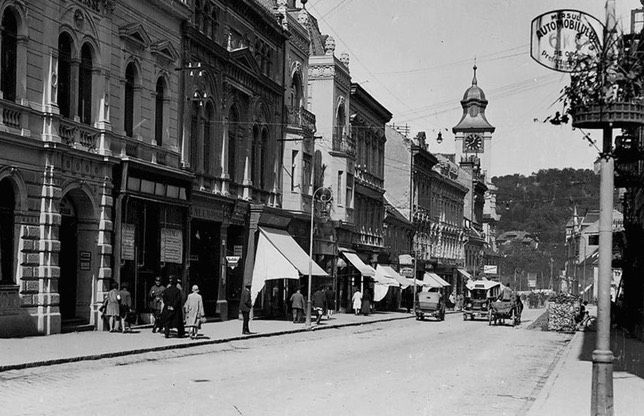Muresenilor street was originally named the Monastery Street, after a Dominican convent situated on its northern side. Later on it was called the Customs Street, because the custom house was close to the Bastion of the Gate, which stood at the end of the street. During the Middle Ages, this street was the main access way used by the tradesmen and travelers that was coming from Walachia via Bran.
Following the tolerance edict pronounced by Emperor Joseph II in 1771, the gates of the fortress were opened to the Romanian traders from Șchei or from Walachia, but also to the Greek, the Macedonian, the Armenian and the Jewish tradesmen. In a backyard, at 12 Barițiu Street, the construction of St. Trinity Orthodox church was accepted, a place of worship that was consecrated in 1788, for both the Romanian and the Greek believers, the divine service being officiated alternately in Romanian and in Greek. It has been known as the “Greek Church”. It was only in 1896 that the Assumption parish church was erected on the site of a former small chapel. The new church was dedicated solely to the Romanian Orthodox believers, but, again, the façade did not overlook the street. The design reminds of the Baroque hall-type church, rather than of the three apse or trefoil style specific to the Orthodox churches.
In 1934 was begun the construction of the Annunciation Orthodox church, in Byzantine style. The iconostasis is a carved wooden one, brought from St. Nicholas church of Șchei, to which it had been presented by Elisaveta Petrovna, Empress of Russia, in 1751. The iconostasis was restored and endowed with new icons in 1952.
The Roman-Catholic church situated in Muresenilor Street whose patron saints are the archangels Michael, Gabriel and Raphael. It was erected 1776-1782, on the site of a former chapel that had belonged to the Dominican monastery since 1323, and in which the religious service was officiated in Hunagrian. The Roman-Catholic church is the most important Baroque monument in the whole of Brașov fortified town.
The Mureșianu family is famous for the scholars and patriots it produced; all of them fought for the civil and political rights of the Romanians in Transylvania, in the 19th century. Andrei Mureșianu, the poet of the 1848 revolution, wrote the lyrics of the song “Deșteaptă-te române” which was to become Romania’s National Anthem. The building was taken over by Mureșianu family in 1840.
The Ambient team is waiting for you in Brașov

